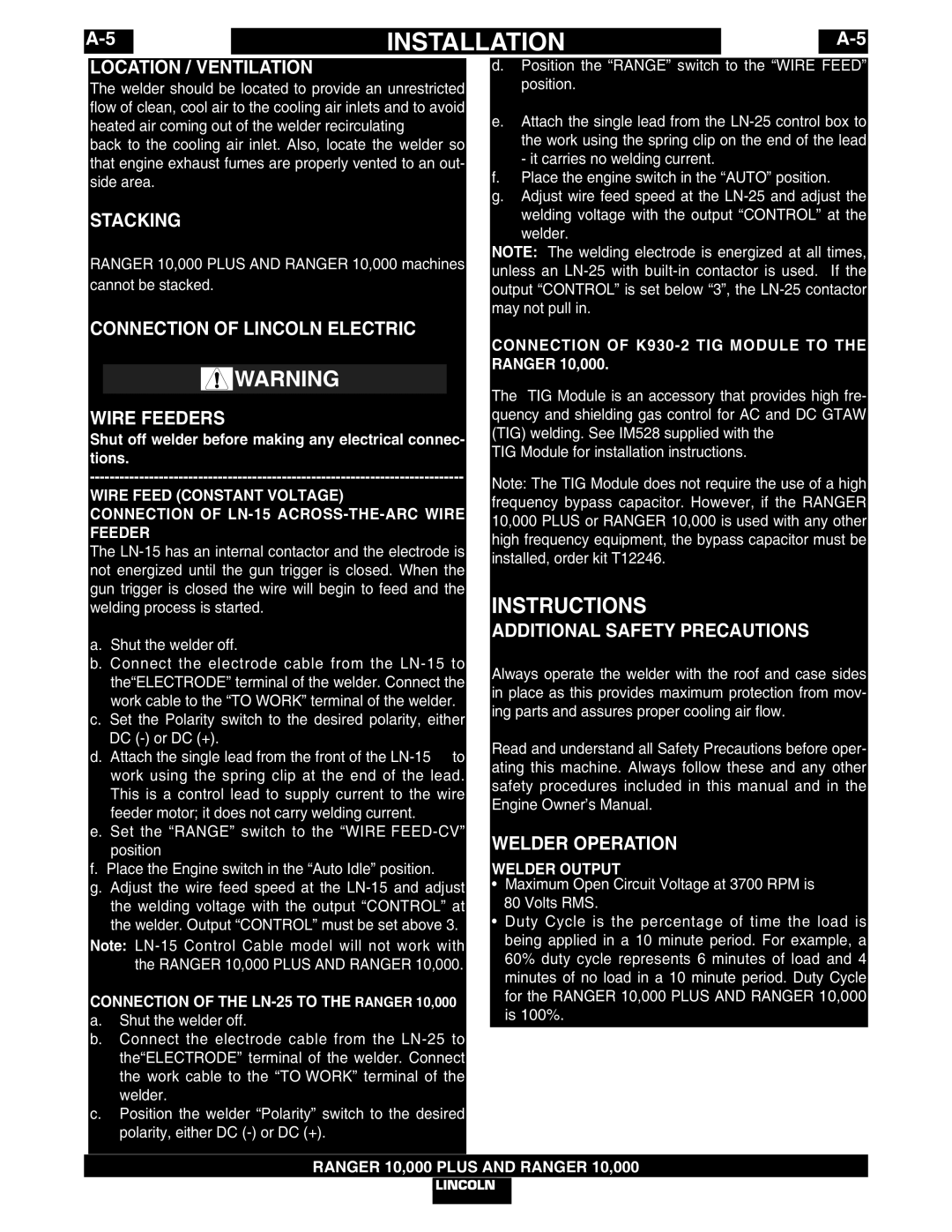
INSTALLATION | ||
|
|
|
LOCATION / VENTILATION
The welder should be located to provide an unrestricted flow of clean, cool air to the cooling air inlets and to avoid heated air coming out of the welder recirculating
back to the cooling air inlet. Also, locate the welder so that engine exhaust fumes are properly vented to an out- side area.
STACKING
RANGER 10,000 PLUS AND RANGER 10,000 machines cannot be stacked.
CONNECTION OF LINCOLN ELECTRIC
![]() WARNING
WARNING
WIRE FEEDERS
Shut off welder before making any electrical connec- tions.
WIRE FEED (CONSTANT VOLTAGE)
CONNECTION OF
The
a.Shut the welder off.
b.Connect the electrode cable from the
c.Set the Polarity switch to the desired polarity, either DC
d. Attach the single lead from the front of the
e.Set the “RANGE” switch to the “WIRE
f.Place the Engine switch in the “Auto Idle” position.
g.Adjust the wire feed speed at the
Note:
CONNECTION OF THE LN-25 TO THE RANGER 10,000
a.Shut the welder off.
b.Connect the electrode cable from the
c.Position the welder “Polarity” switch to the desired polarity, either DC
d.Position the “RANGE” switch to the “WIRE FEED” position.
e.Attach the single lead from the
f.Place the engine switch in the “AUTO” position.
g.Adjust wire feed speed at the
NOTE: The welding electrode is energized at all times, unless an
CONNECTION OF K930-2 TIG MODULE TO THE RANGER 10,000.
The TIG Module is an accessory that provides high fre- quency and shielding gas control for AC and DC GTAW (TIG) welding. See IM528 supplied with the
TIG Module for installation instructions.
Note: The TIG Module does not require the use of a high frequency bypass capacitor. However, if the RANGER 10,000 PLUS or RANGER 10,000 is used with any other high frequency equipment, the bypass capacitor must be installed, order kit T12246.
INSTRUCTIONS
ADDITIONAL SAFETY PRECAUTIONS
Always operate the welder with the roof and case sides in place as this provides maximum protection from mov- ing parts and assures proper cooling air flow.
Read and understand all Safety Precautions before oper- ating this machine. Always follow these and any other safety procedures included in this manual and in the Engine Owner’s Manual.
WELDER OPERATION
WELDER OUTPUT
•Maximum Open Circuit Voltage at 3700 RPM is 80 Volts RMS.
•Duty Cycle is the percentage of time the load is being applied in a 10 minute period. For example, a 60% duty cycle represents 6 minutes of load and 4 minutes of no load in a 10 minute period. Duty Cycle for the RANGER 10,000 PLUS AND RANGER 10,000 is 100%.
RANGER 10,000 PLUS AND RANGER 10,000
Constant Current | 225 Amps AC @ 25 Volts |
|
| 210 Amps DC @ 25 Volts |
|
|
|
|
Constant Voltage | 200 Amps DC @ 20 Volts |
|
|
|
|
